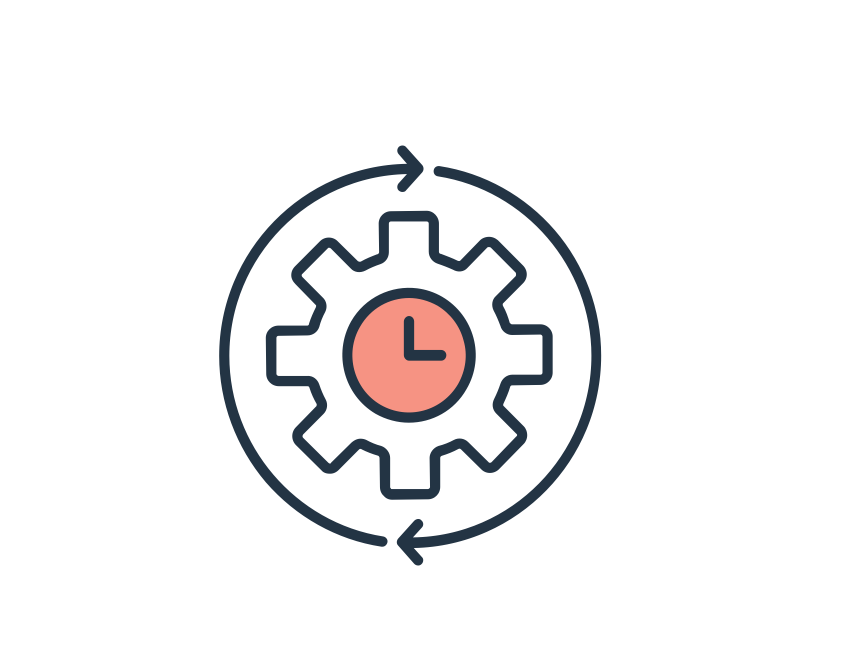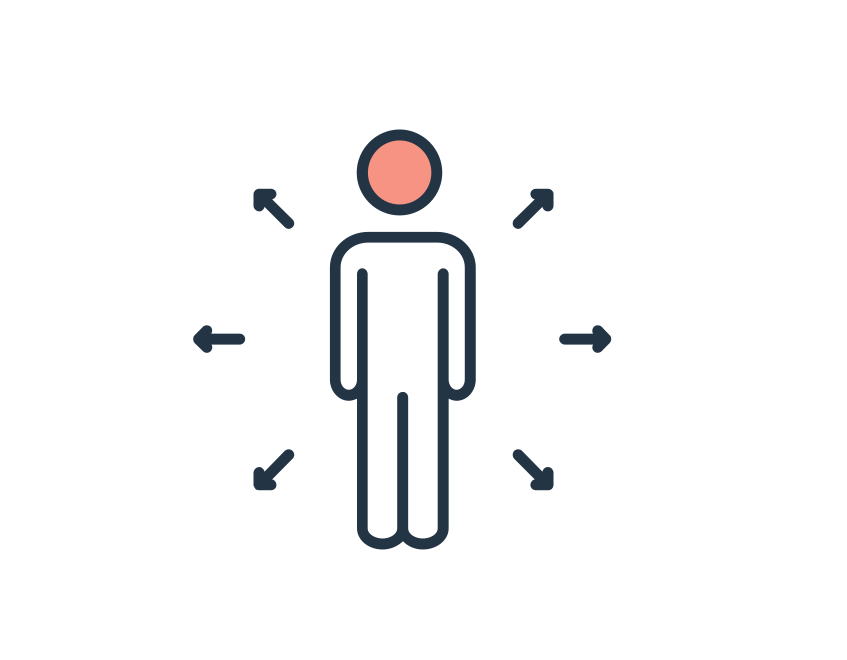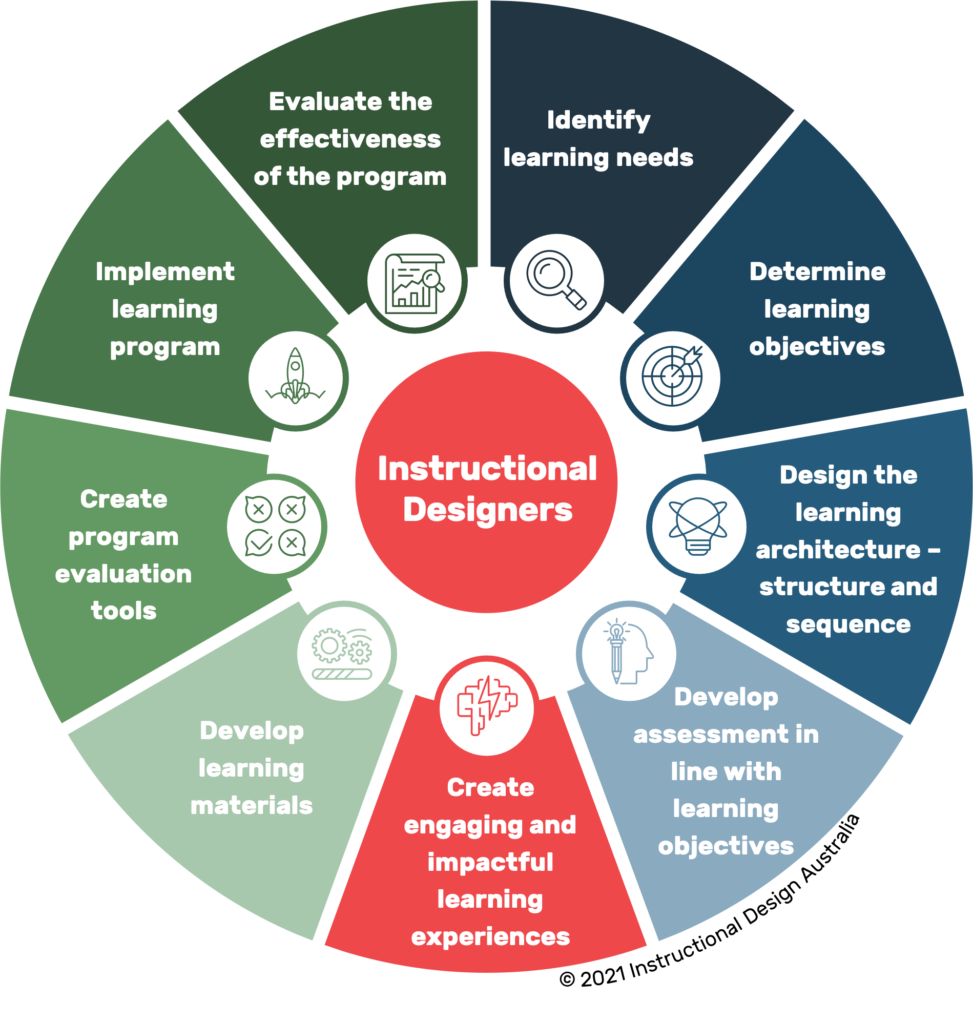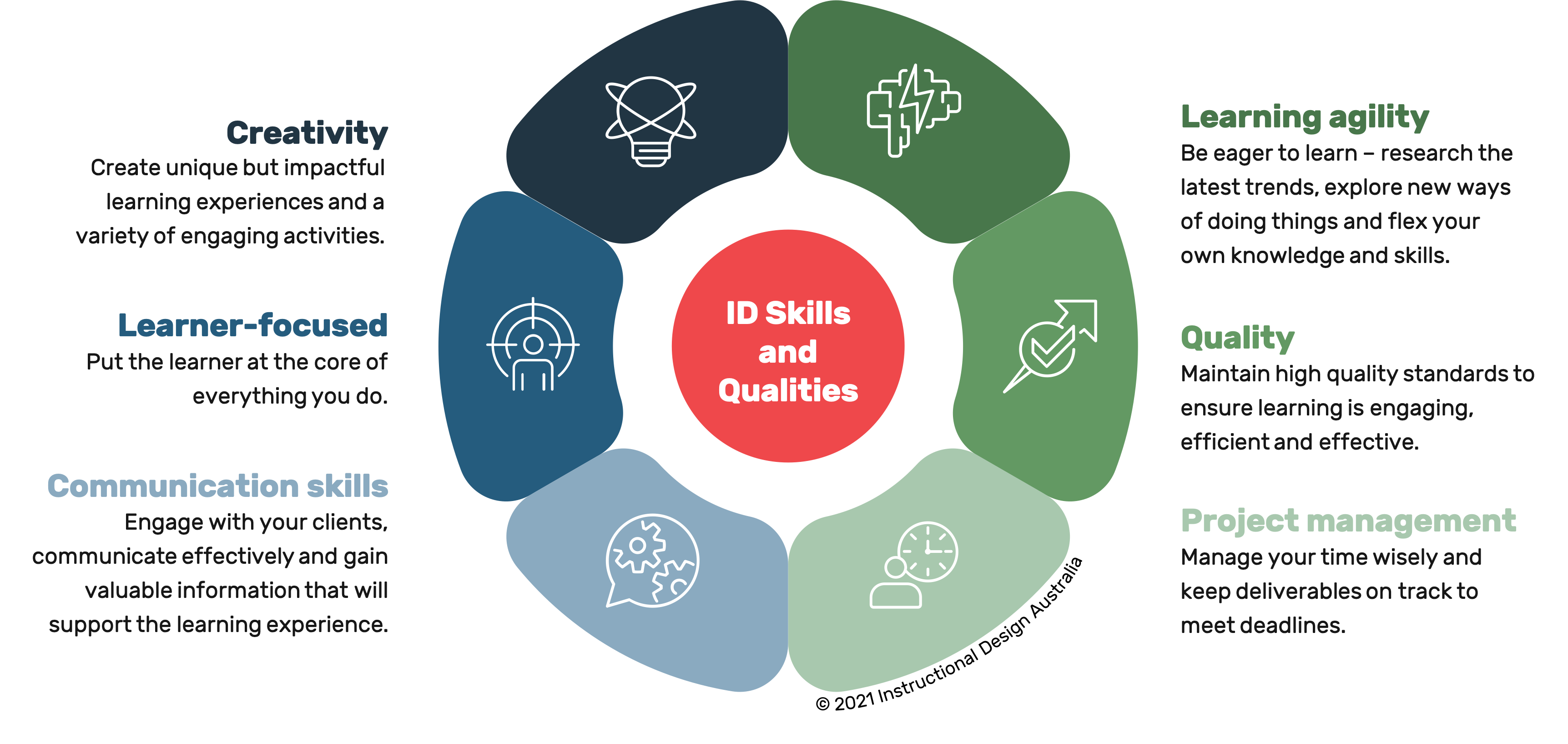What Do Instructional Designers Do?
In summary, an Instructional Designer can do the following…
An Instructional Designer can:
- Analyse learning needs and then systematically develop instruction
- Study instructional theories, tools and resources to develop methods that facilitate learning
- Use current research in educational psychology, educational theory and systems analysis to ensure the most suitable teaching methods are used
- Base their decisions on proven instructional design methods
- Use pedagogically sound teaching methods and the latest technology to design effective learning products
- Draw from their deep knowledge of the various strategies and technologies that can be applied to course design
- Work with Subject Matter Experts (SME) or “content specialist”
- Create:
- Online and distributed learning courses
- Tutorials
- Workshops
- Training manuals
- Seminars
- Training videos
- Assessments
- Plan and implement the most effective training strategies
- Integrate feedback, student support, assessment and course evaluation into the training program
- Work with multimedia designers and programmers to implement the design
- Evaluate the effectiveness of the learning product
Instructional designers might also be called:
- Learning designer
- Learning experience designer (LXD)
- eLearning developer
- Learning and development specialist
- Educational designer
Instructional designers may dabble in:
- Graphic design
- Desktop publishing
- Video/podcast production
An exceptional Instructional Designer has the following skills…
Some Instructional Designers will have a broad range, or specialised, skills in one or more of the following areas:
- Designing and developing eLearning programs and assessment quizzes in authoring tools, including StoryLine and RISE
- Creating ASQA-compliant accredited learning and assessment material
- Combining ASQA-compliant accredited training with complex, organisationally-specific operational needs
Recommended reading:
- Don Clarke discusses seven theories for designing learning environment
Why become an Instructional Designer?

Embrace the freedom of working remotely or as a digital nomad.

Enjoy flexible hours that fit your lifestyle.

Explore the versatility of freelancing or collaborating in a team.

Channel your creativity and problem-solving abilities into designing effective learning experiences.

Say goodbye to monotony - every project requires curiosity and new thinking.

Make a meaningful impact by helping others to learn and grow.

Constantly expand your knowledge and skills in a dynamic role.

Join a thriving industry, where your new skills are in demand! 21.7% projected job growth in 5 years (Seek, 2023)
Learn more
FAQs
Instructional design is the art of crafting impactful learning experiences, and at its heart lie three major components:
- Analysis: This is the detective work! Before diving into design, it’s essential to understand the learners’ needs, objectives, and the context. Who are our learners? What do they need to know?
- Design & Development: Here’s where creativity meets strategy. Using insights from the analysis, designers map out the learning journey and then create compelling content, activities, and resources.
- Implementation & Evaluation: The finale! The designed content is delivered to the learners. But the journey doesn’t end; feedback is gathered, and the design is refined, ensuring the learning experience is always top-notch.
These pillars guide instructional designers in creating meaningful and effective educational adventures.
A teacher and an instructional designer both play pivotal roles in the realm of education, but they focus on different aspects of the learning process. Here’s a breakdown of their distinct roles:
Teacher:
- Direct Interaction: Teachers engage directly with learners, facilitating learning in classrooms or online environments.
- Delivery: They present and explain content, answering questions, and guiding discussions.
- Assessment: Teachers evaluate students’ performance through tests, assignments, and observations.
- Feedback: They provide real-time responses to students, helping them understand and improve.
- Adaptability: In live settings, teachers can adjust their approach based on immediate feedback from students.
Instructional Designer:
- Behind-the-Scenes: Instructional designers often work in the background, crafting the structure and content of learning experiences.
- Blueprint Creation: They plan the learning journey, defining objectives, content flow, and assessment strategies.
- Multimedia Integration: They might incorporate various technologies and multimedia elements to enhance learning.
- Evaluation & Refinement: Based on feedback and results, they refine courses or materials for better outcomes.
- Broad Scope: While teachers often focus on specific groups of students, instructional designers might create materials for large, diverse audiences or specialized niches.
In essence, while teachers focus on delivering and facilitating education, instructional designers specialize in the planning and construction of educational experiences. Both roles are essential for a holistic and effective learning ecosystem.
Graphic designers and instructional designers both operate in the realm of design, but they apply their skills to different objectives and mediums. Here’s a breakdown of their distinct roles:
Graphic Designer:
- Visual Focus: The primary role of a graphic designer is to create visually compelling and coherent graphics, illustrations, layouts, and visual content.
- Branding & Identity: They often work on developing logos, brand guidelines, and visual identities for businesses or products.
- Diverse Applications: Their work can span various media, including print (like posters, brochures, magazines) and digital (like websites, banners, social media graphics).
- Aesthetics & Usability: They consider factors such as color theory, typography, and visual hierarchy to ensure both attractiveness and functionality of designs.
- Tools Mastery: Graphic designers typically work with software like Adobe Creative Suite (Illustrator, Photoshop, InDesign) or other visual design tools.
Instructional Designer:
- Educational Focus: The main objective of an instructional designer is to create effective, engaging, and efficient educational experiences.
- Learning Outcomes: They start by identifying learning objectives and then design content and activities to achieve those objectives.
- Pedagogical Strategy: Their designs are rooted in educational theories and best practices to ensure optimal learning outcomes.
- Multimedia Integration: While they might work with graphic elements, they also consider other components like interactivity, assessments, videos, and simulations.
- Feedback & Iteration: Instructional designers regularly assess the effectiveness of their designs and refine based on feedback and results.
In summary, while graphic designers emphasize visual communication and aesthetics, instructional designers focus on structuring and optimizing the learning experience. Both roles, however, value clarity, engagement, and user experience in their respective designs.
Yes! According to Seek.com.au, there is a 21.7% projected job growth in the next 5 years.
Instructional designers are sought-after, driven by a surge in online and blended learning, especially post-COVID-19. The corporate sector’s growing emphasis on employee training and the rise of eLearning platforms further fuel this demand. Government initiatives supporting digital education have also boosted the need for these professionals. With Australia’s education sector, especially higher education, constantly innovating, instructional designers play a pivotal role in creating effective learning experiences.
The “5 C’s of Instructional Design” isn’t a universally recognised or standardised framework in the instructional design community.
However, depending on sources or specific applications, there are different versions of “C” frameworks that relate to instructional design or education. One such model consists of:
- Content: Refers to the subject matter or information educators want learners to understand. The instructional designer determines what content is essential and organizes it in a logical sequence.
- Context: Encompasses the learning environment, considering how, when, and where the learning will occur. This might involve deciding between online modules, face-to-face sessions, or blended learning solutions.
- Condition: Focuses on the learners’ pre-existing knowledge and skills, ensuring that the instruction is tailored to the learners’ starting point.
- Criteria: Defines how success will be measured. This entails setting clear objectives and establishing how learners’ mastery of these objectives will be assessed.
- Components: These are the tools, resources, and strategies employed in the design. It might involve multimedia elements, interactive tasks, or specific pedagogical techniques.
While this “5 C’s” model can serve as a guideline, instructional designers often draw upon various frameworks and methodologies depending on the project’s unique requirements and objectives.
Whether being an instructional designer is “worth it” depends on individual preferences, career goals, and market conditions. However, here are some factors to consider that highlight the pros and potential challenges of this profession:
Pros:
- Growing Demand: With the rise of e-learning, online platforms, and corporate training needs, instructional design is seeing an increase in demand in many regions.
- Flexibility: Many instructional design roles offer remote working options or flexible hours.
- Diverse Opportunities: Instructional designers can work in various sectors, from education to corporate to government and nonprofit.
- Professional Development: The field requires continuous learning about new tools, technologies, and pedagogical strategies, offering opportunities for personal growth.
- Impact: Instructional designers can make a direct impact on learners, improving educational experiences and outcomes.
Potential Challenges:
- Rapid Technological Change: The tools and platforms used can evolve rapidly, requiring designers to continuously adapt.
- Varied Skill Set: The role might require skills ranging from project management to multimedia editing to pedagogical knowledge, which can be demanding.
- Client/Subject Matter Expert Challenges: Working with subject matter experts or clients to extract and organise information can sometimes be challenging.
Ultimately, the decision to pursue a career as an instructional designer should be based on personal interests in education and design, career aspirations, and an assessment of the job market in your region. It might be beneficial to connect with current instructional designers or join professional organisations to gain more insights into the profession.
While instructional design and curriculum development are closely related and often overlap, they are not the same. Each has its distinct focus, scope, and processes. Here’s a comparison:
Instructional Design:
- Focus: Involves creating systematic and effective learning experiences through a process of analysing learners’ needs, defining clear learning objectives, designing appropriate instructional materials, and evaluating the effectiveness of these experiences.
- Scope: Can be applied to various contexts, from a single training module or eLearning course to a series of workshops or lessons.
- Processes: Typically follows models like ADDIE (Analyse, Design, Develop, Implement, and Evaluate) or SAM (Successive Approximation Model).
- Tools & Techniques: Involves integrating multimedia, interactivity, and various technologies to facilitate learning.
- Outcomes: Concentrates on immediate learning objectives and the strategies to achieve them efficiently.
Curriculum Development:
- Focus: Refers to the overarching planning of educational programs or courses, often at a more macro level than instructional design.
- Scope: Looks at the broader educational journey, which might encompass an entire degree program, school year, or multi-course sequence.
- Processes: Involves determining what should be taught (content), how it should be taught (pedagogy), and in what sequence (structure), often considering national or institutional standards.
- Tools & Techniques: Tends to consider textbooks, resources, syllabi, assessment methods, and broad teaching strategies.
- Outcomes: Emphasises longer-term goals such as preparing students for a career, achieving competencies, or fulfilling accreditation requirements.
While there are differences, these fields often intersect. An instructional designer might work within the boundaries set by a curriculum developer, and a curriculum developer might use instructional design principles to ensure the effectiveness of the broader educational plan. In many settings, especially smaller institutions or teams, the same person might wear both hats.




